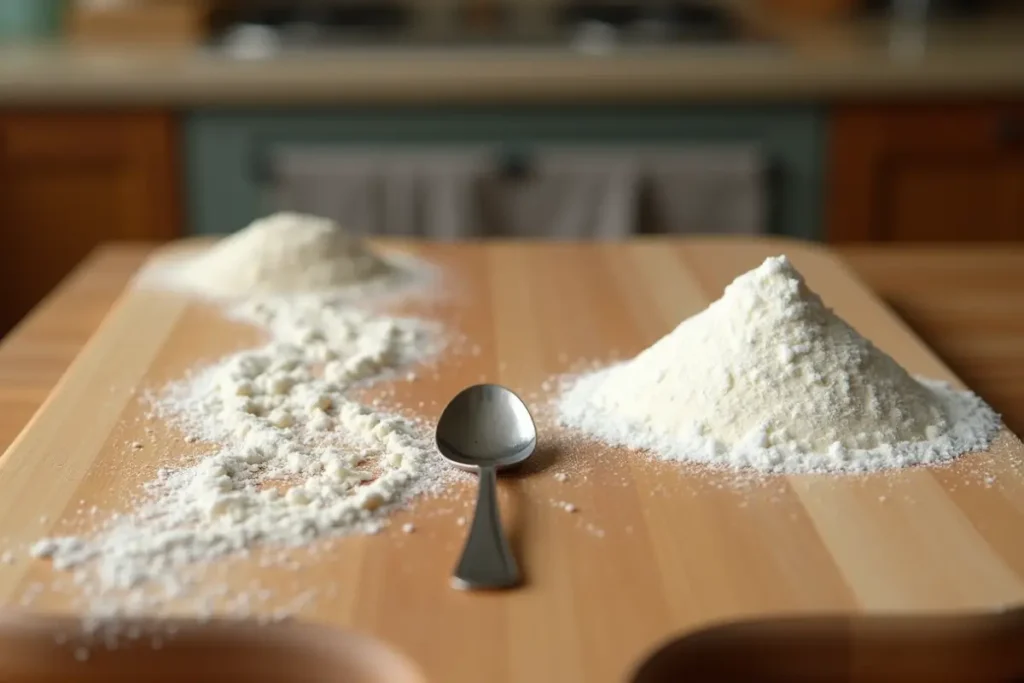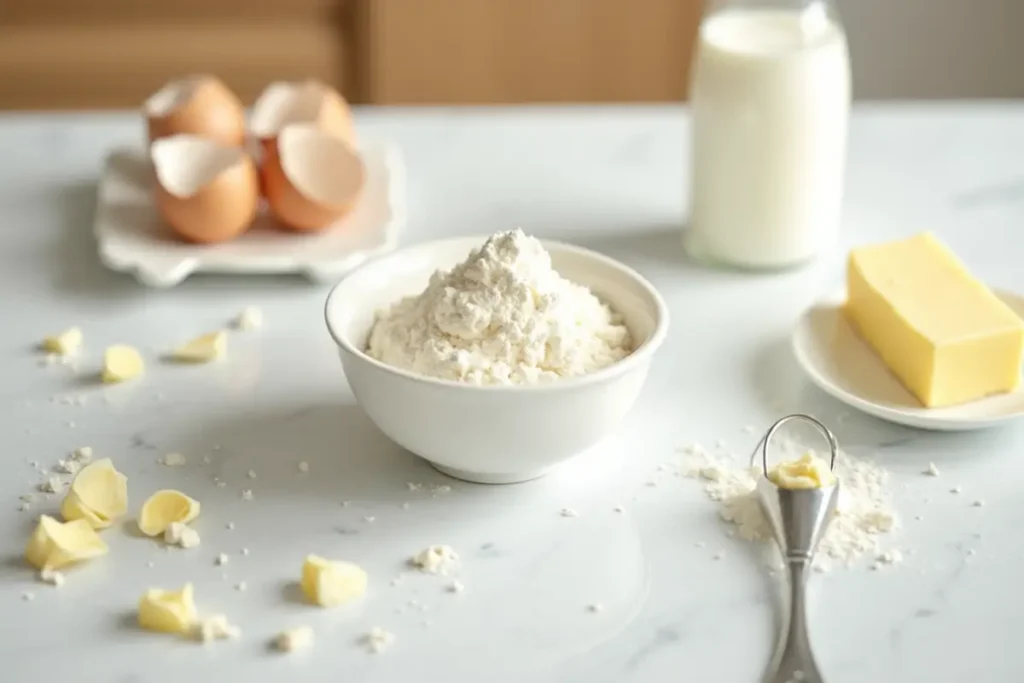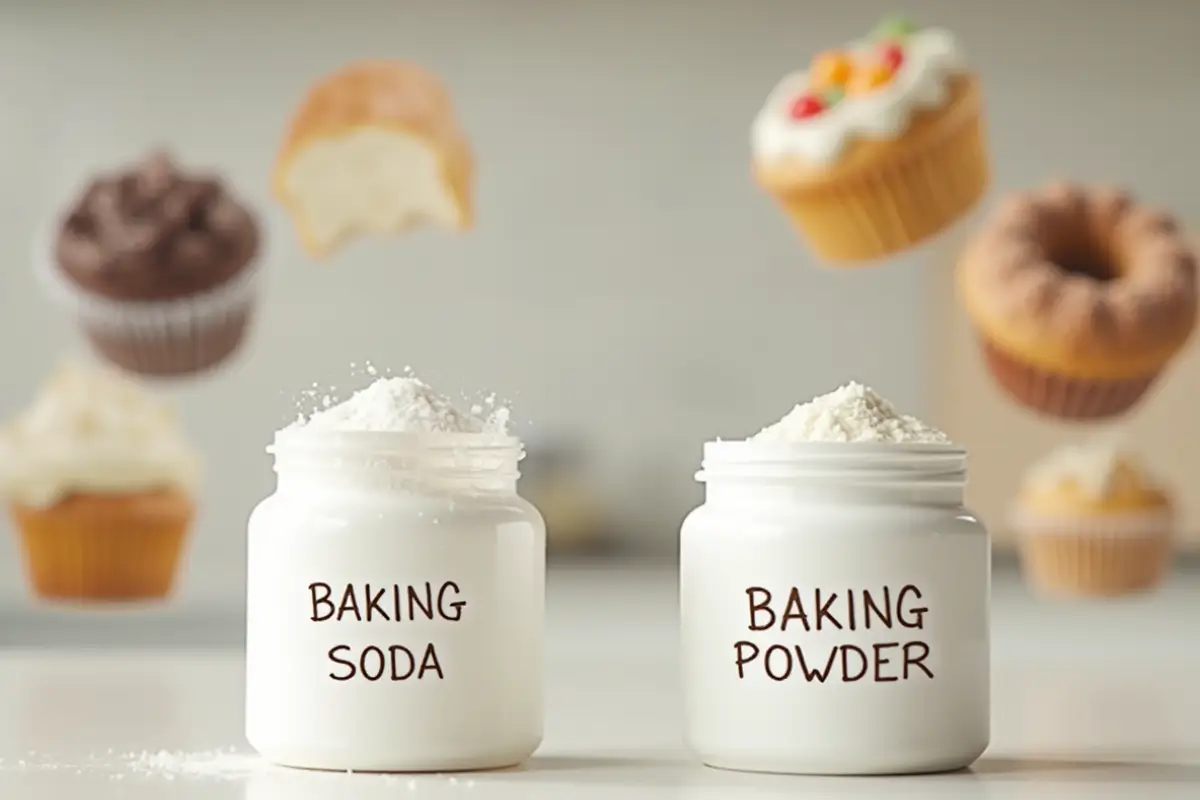Have you ever been in your kitchen, the smell of vanilla and sugar filling the air, and then, perhaps with great anticipation, you pull out a cake that is flatter than a pancake? The joy of baking can indeed quickly become disappointing when your treats don’t rise the way you want them to. You know that sinking feeling, right? In fact, it’s a common experience for many. More often than not, the culprit, surprisingly, is baking powder. This simple ingredient is a hero, in its own right. It works to give your cakes, muffins, and biscuits that perfect lift. Therefore, let’s explore baking powder together, so that we can discover its secrets, and ensure your bakes are always perfect. You’re about to unlock the power of this essential kitchen item.
What Makes Baking Powder Work? The Science Behind the Rise
Before embarking on your next baking adventure, let’s see what baking powder actually is. It helps things rise, as you know. Essentially, baking powder is a complete leavening agent. It contains all the components needed to make carbon dioxide. This gas, in turn, makes your baked goods light and fluffy. Furthermore, unlike baking soda, baking powder doesn’t need any extra acid to work. This feature makes it reliable for many recipes.
The magic happens with specific ingredients:
- Sodium Bicarbonate: This is the base, and it is also called baking soda. Specifically, it releases carbon dioxide when it reacts with an acid and a liquid.
- An Acid: Common acids are cream of tartar, sodium acid pyrophosphate, or even sodium aluminum sulfate. These acids react with the sodium bicarbonate. This, in essence, starts the leavening process. However, different baking powders use different acids. As a result, this causes slight differences, mainly between single and double acting powders.
- A Starch: Usually cornstarch is used. It buffers and absorbs moisture. This stops the base and acid from reacting too soon. Additionally, it prevents clumps. In this way, it ensures you have consistent results every time.
When these mix with moisture and heat, a chemical reaction happens. Carbon dioxide gas is produced. Essentially, think of it as tiny balloons. They are created inside your batter or dough. Then, this gas expands in the oven. It causes your baked goods to rise and become light and airy. Pretty amazing, right?
Single vs. Double: Exploring Different Types of Leavening
You know the science behind baking powder. Now, you need to know the different types. In fact, each type can affect your recipes. For instance, the two main types are single-acting and double-acting.
- Single-Acting Baking Powder:
- As a matter of fact, this type reacts right away when in contact with liquid.
- Consequently, you must get your batter in the oven quickly after mixing. The leavening starts as soon as you mix wet and dry ingredients.
- Because of this immediate reaction, single-acting powder is not common now. You are not likely to find it at the store.
- Double-Acting Baking Powder:
- Generally, this is the common type in stores. It reacts twice. It reacts when mixed with liquid, and also again when heated.
- This two-stage reaction gives you more time. Therefore, it does not need to be immediately put in the oven.
- In addition, this type allows you to thoroughly mix batter or dough before the second rise in the oven. This, therefore, makes for a more consistent and predictable rise.
The main difference, therefore, is the timing of the leavening. Therefore, double-acting powder is more common. Moreover, it provides more flexibility. This, in turn, makes baking easier and gives reliable results.
Baking Powder vs. Baking Soda: Understanding the Key Differences

Baking soda is a component of baking powder, and it can be, admittedly, confusing. It’s a common mix-up. Therefore, it’s important to know the difference between them. Both help recipes rise. However, they do it differently. You need to understand their specific roles, firstly.
- Baking Soda: This is sodium bicarbonate. It’s the alkaline base in baking powder. By itself, it doesn’t have enough components to react with liquid. It doesn’t create the carbon dioxide you need. Baking soda requires liquid and an acid. Lemon juice, buttermilk, or yogurt work. This activates the soda. Subsequently, it produces the carbon dioxide to make your cakes and pastries rise.
- Baking Powder: It is a complete leavening agent. It contains the base (sodium bicarbonate) and acid. It only needs moisture and heat. As such, it produces carbon dioxide without needing any extra acids.
Understanding this, of course, is important. Both help baked goods rise. However, you can’t substitute them carelessly. If your recipe has acid, use baking soda. Otherwise, baking powder is best.
Here’s a table to compare them:
| Feature | Baking Soda | Baking Powder |
| Main Component | Sodium Bicarbonate | Sodium Bicarbonate, Acids, and Starch |
| Need Acid | Yes | No |
| Leavening | Does not leaven by itself | Leavens when liquid and heat are introduced |
How to Use Baking Powder Correctly for Baking Success
You know what baking powder is and its differences. Now, let’s talk about how to use it for best results. Using baking powder correctly is about accuracy, mixing, and storage. This, in turn, maintains its power.
- Measuring: Accurate measurements are crucial. Too much powder can easily make a metallic taste. It can also, as a result, cause cakes to rise too fast and then collapse. Not enough will make baked goods flat and dense. Therefore, use measuring spoons and level them off carefully.
- Mixing: Add baking powder to dry ingredients. Whisk the dry ingredients to distribute it evenly. Even distribution means all parts of the batter rise evenly. Ultimately, this makes for a balanced texture that we all want.
- Storage: Baking powder is sensitive to moisture. Store it in a cool, dry place, and in an airtight container. If you live in a humid area, store it in the refrigerator. Keep it dry, and in a sealed container.
- Freshness Test: Baking powder can eventually lose its power. To test it, mix a teaspoon of powder with 1/3 cup of hot water. If it bubbles a lot, it’s good. If it doesn’t, replace it. Therefore, always use fresh powder for best results.
How much baking powder should I use?
You might be wondering, how much baking powder is actually needed? Essentially, the amount depends on the flour and the baked good.
- Cakes, Muffins, and Cupcakes: Use 1 teaspoon of baking powder for each cup of flour. However, if the recipe has acid like yogurt, use less powder and use baking soda instead.
- Other Baked Goods: For recipes with less gluten, like quick breads, biscuits, and scones, more baking powder gives a tender, fluffy result. In general, use about 1.5 teaspoons per cup of flour.
- Too Much Baking Powder: In fact, this can cause a metallic taste. It can make baked goods rise too fast and, therefore, collapse. It can also cause a coarse texture.
- Not Enough Baking Powder: This makes baked goods dense and flat. They will also have a tough texture and bad quality. Therefore, always use fresh powder and in the correct amounts.
Baking Powder Substitution Guide
Sometimes, you might run out of baking powder. You can substitute it, but it might not be exactly the same. Here’s how to substitute:
- Use Baking Soda with Acid: If you have baking soda and an acid, you can substitute it. Mix 1/4 teaspoon of baking soda with 1/2 teaspoon of lemon juice or vinegar. Alternatively, use 1/2 cup of buttermilk for the liquid in your recipe. Use this if your recipe is already acidic.
- Important Note: Do not use baking soda alone for baking powder. This will cause flat, dense, bad-tasting results. Furthermore, it wont rise well.
- General rule: Substitute 1 teaspoon of baking powder with 1/4 tsp baking soda plus 1/2 tsp of lemon juice or vinegar, or with half a cup of buttermilk.
Simple Recipes using Baking Powder

Let’s now put this knowledge to good use with some easy recipes. Baking powder is, indeed, very important in these recipes, as you will see.
Recipe 1: Simple Pancakes
| Ingredient | Measurement |
| Flour | 1 cup |
| Sugar | 2 tablespoons |
| Baking Powder | 2 teaspoons |
| Salt | 1/4 teaspoon |
| Milk | 1 cup |
| Egg | 1 |
| Melted Butter | 2 tablespoons |
Instructions:
- First, in a bowl, whisk together the flour, sugar, baking powder, and salt.
- Then, add the milk, egg, and melted butter. Stir until just combined. Remember not to overmix, please.
- Next, heat a lightly oiled pan on medium heat.
- After that, pour ¼ cup of the batter onto the pan for each pancake.
- Subsequently, cook for 2-3 minutes per side. They should be golden brown and cooked through.
- Finally, serve with your favorite toppings.
Recipe 2: Basic Biscuits
| Ingredient | Measurement |
| Flour | 2 cups |
| Baking Powder | 1 tablespoon |
| Salt | 1/2 teaspoon |
| Shortening | 1/2 cup |
| Milk | 3/4 cup |
Instructions:
- Initially, preheat your oven to 450°F.
- Then, in a bowl, whisk together the flour, baking powder, and salt.
- Following that, cut in the shortening using a pastry blender or fork. Specifically, it should look like coarse crumbs.
- After this, add the milk and stir until just combined.
- Next, turn the dough onto a lightly floured surface. Knead a few times, gently.
- Then, roll out the dough to ½ inch thick. Cut out biscuits using a cookie cutter.
- Lastly, place the biscuits on a baking sheet and bake for 10-12 minutes. They should, of course, be golden brown.
Recipe 3: Simple Muffins
| Ingredient | Measurement |
| Flour | 2 cups |
| Sugar | 1/2 cup |
| Baking Powder | 2 teaspoons |
| Salt | 1/4 teaspoon |
| Egg | 1 |
| Milk | 1 cup |
| Vegetable Oil | 1/4 cup |
Instructions:
- First, preheat oven to 400°F. Grease or line a muffin pan.
- Then, in a bowl, whisk the flour, sugar, baking powder, and salt.
- After that, in a separate bowl, whisk together the egg, milk, and vegetable oil.
- Next, pour the wet ingredients into the dry ingredients. Stir until just combined.
- Following that, fill each muffin cup about 2/3 full.
- Finally, bake for 15-20 minutes, or until a toothpick inserted into the center comes out clean.
Troubleshooting Common Baking Powder Problems
Even with care, baking can sometimes go wrong. Therefore, let’s troubleshoot some problems linked to baking powder.
- Flat Cakes: If your cakes aren’t rising, make sure the powder is fresh. Also, use the right amount for your recipe. Also, do not overmix the batter. This can develop too much gluten and lead to a flat cake.
- Dense Textures: Dense textures can happen with not enough baking powder. Additionally, overmixing your batter can cause it as well. Combine ingredients until just combined. Avoid mixing too much, please.
- Metallic Taste: Too much baking powder causes a metallic taste. Measure your ingredients accurately. Remember, too much baking powder is worse than too little.
- Uneven rise: Evenly distribute the baking powder in your dry ingredients. This ensures an even rise. Consequently, if it isn’t distributed, it can cause uneven rising in your baked goods.
What Sides Go With Baking?
Baking offers endless possibilities, from savory bread to sweet desserts. However, choosing the right sides to complement your baked goods can turn a simple dish into a complete meal. Here are some great options:
1. Fresh Fruits
To begin with, fresh fruits like berries, apples, or citrus slices pair beautifully with sweet baked treats. Moreover, their natural sweetness and tartness balance rich flavors, making them a versatile choice that works for nearly any dessert.
2. Whipped Cream or Ice Cream
Additionally, adding a creamy side can elevate any baked good. For example, try making your own whipped cream with the Homemade Heavy Cream guide. Alternatively, a scoop of vanilla or chocolate ice cream works wonders with warm baked desserts, enhancing their texture and flavor.
3. Savory Sides
If your baked dish leans toward the savory side, pair it with a fresh salad or roasted vegetables. Furthermore, the contrast in textures and flavors creates a balanced plate, ensuring your meal feels both satisfying and nutritious.
4. Creative Dessert Pairings
For sweet bakes like brownies or cookies, consider serving them alongside layered desserts like the Brookie Recipe. In addition to adding variety, this combination creates a more indulgent dessert spread that is perfect for entertaining.
5. Ingredient Insights
To better understand how to perfect your baked creations, explore What Do Eggs Do in a Cake?. Specifically, learning about the role of ingredients can inspire creative pairings and recipe tweaks, giving you greater control over the results.
6. Complementary Bakes
Lastly, complement your main bake with smaller delicacies like Cream Puffs. Not only are these light, airy treats delightful, but they also make an excellent addition to a baking-themed meal, providing contrast in texture and flavor.
By pairing baked goods with these sides, you can create a meal or dessert experience that is both diverse and satisfying. Whether you’re hosting a gathering or preparing a cozy family meal, these ideas are sure to impress!
Frequently Asked Questions (FAQ) About Baking Powder
Here are some common questions about baking powder that I will answer:
- Is baking powder gluten-free? Most baking powders are gluten-free. Specifically, they use cornstarch. However, some brands may use wheat starch. Double-check the ingredient list carefully. Look for a certified gluten-free label.
- Can I substitute baking soda for baking powder? You can, but you need an acid. Baking soda alone will not work. However, if your recipe has an acid like buttermilk or lemon juice, use baking soda with it. Otherwise, avoid substituting baking soda on its own.
- How can I test if my baking powder is still good? Mix a teaspoon of powder in ⅓ cup of hot water. If it bubbles a lot, it’s good. If it doesn’t, get a new batch. Therefore, always use fresh powder.
- Does baking powder expire? Yes, baking powder does expire. It loses its potency. Check the expiry date. Replace it when it expires. Indeed, old powder makes baked goods not rise correctly.
- Is baking powder vegan? Yes, most baking powders are vegan. As such, they don’t use animal products. Still, check the list to make sure it doesn’t contain ingredients you need to avoid.
Conclusion:
Baking powder is undoubtedly key to perfect baked goods. You now know how to use it. You also know the difference between it and baking soda. In addition, you know how to store it correctly. With the right measuring, mixing, and storage, you’ll succeed, no doubt. Your cakes, muffins, and biscuits will be perfect. Feel free to experiment and try different recipes. Master your craft. Go bake something amazing! Baking powder is your helper in the kitchen, after all. Finally, share your baking adventures. We would love to see what you create!

